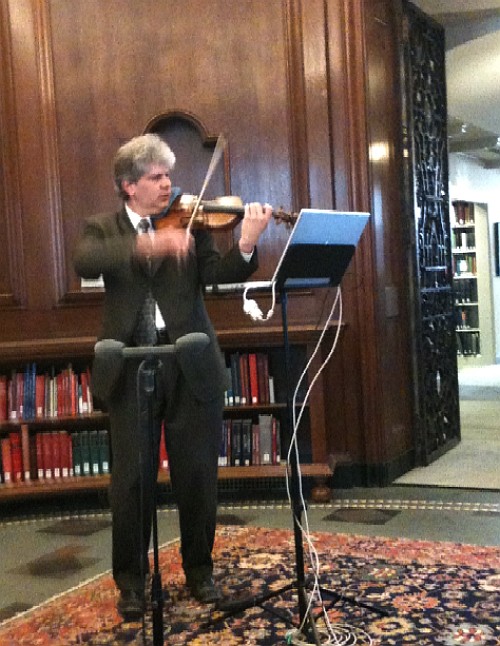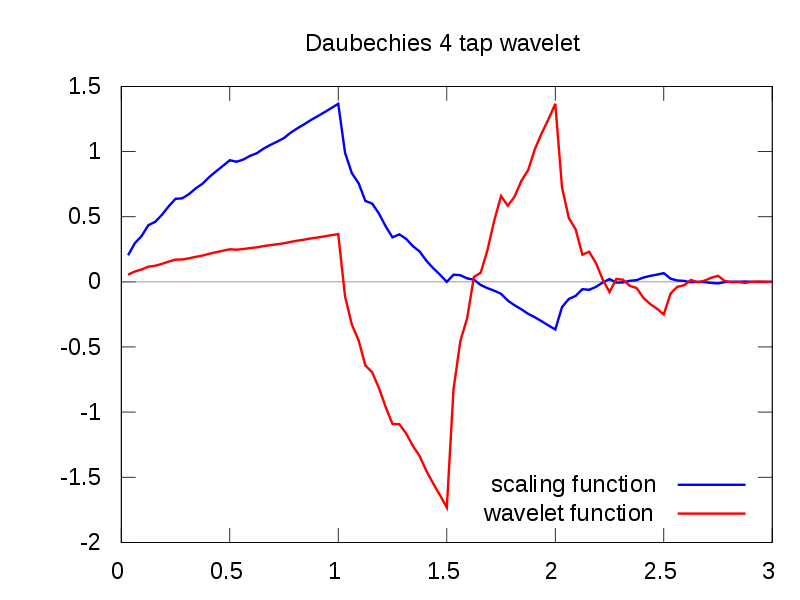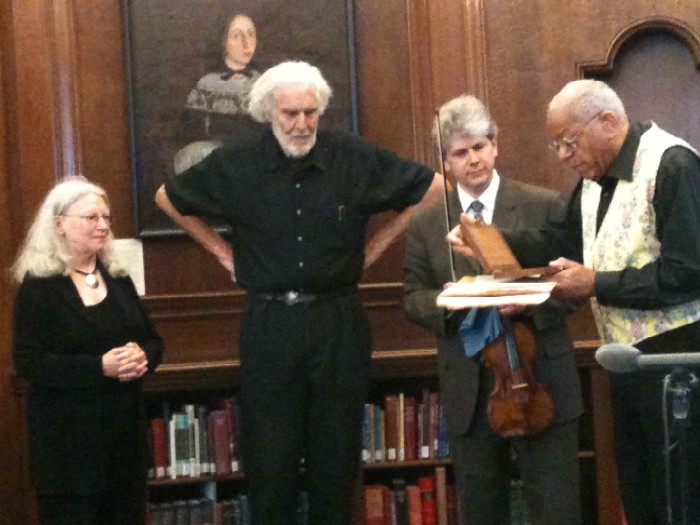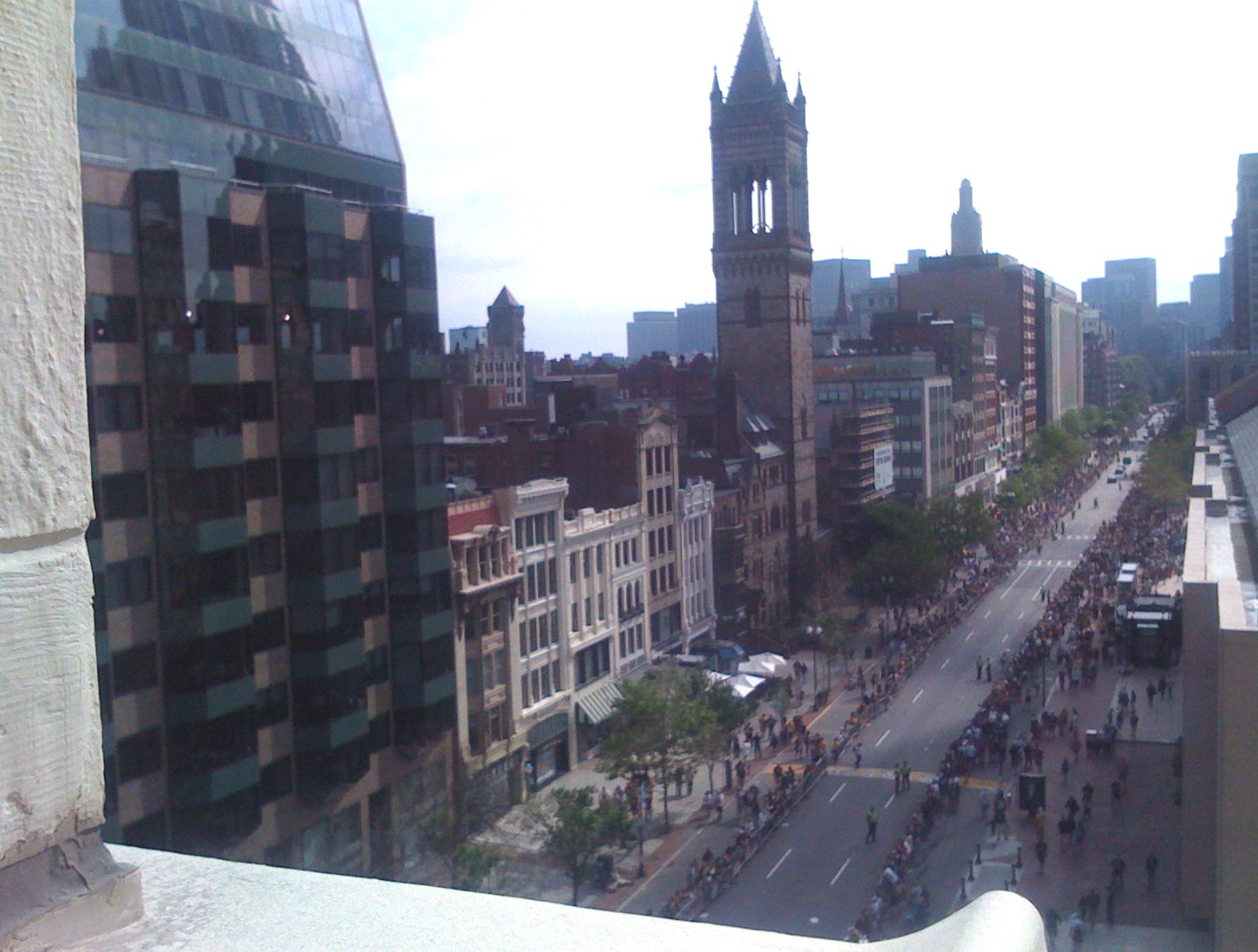
W hen I was, I think, 8 years old, I first heard Bach’s Ciaccona, from the Partita No. 2 in D minor, BWV 1004. I could not stop listening to it. I wore out the record. Afterward, looking at that vinyl record across the room, you could see that that band on the record’s surface… could see that the grooves were completely gone.”
— Nicholas Kitchen, remarks at BEMF recital, New England Historic Genealogical Society, 18-JUN-2011.
T his page in the manuscript [of the Sonatas and Partitas], where the end of the Ciaccona is followed immediately by the beginning of the next Sonata, one right after the other, on the same page—this is what revealed to me that there is a ‘glue’ that Bach had devised that is holding these pieces all together. The multiple pairs and powers-of-2 in these pieces, the recurrences of palindromes and the inversions in these pieces—these are not [conveniences; mere expediencies]. All of these pairs form a great monumental ‘architecture’ upon which emotions can be expressed and better understood.”A lways when you listen to Nicholas Kitchen perform and/or speak, you will learn things that you would never have expected.
— Nicholas Kitchen, remarks at BEMF recital, New England Historic Genealogical Society, 18-JUN-2011.
N icholas’s performance today of major portions of Bach’s solo violin works [Partita No. 1 BWV 1002; Partita No. 2 BWV 1004; Sonata No. 3 BWV 1005; Partita No. 3 BWV 1006] was a complete joy for us. And, amazingly, the acoustics were not bothered at all by the Stanley Cup-winning Boston Bruins and their more than 1 million boisterous fans jamming the streets just outside the recital hall.
K itchen vividly accounted for the correspondences among these works, noting the various plausible motivations for Bach’s G minor-B minor-A minor-D minor-C major-E major affective and intervallic progressions.
M ore than this, though, Kitchen discussed the ingenious sequences of meters and tempi, which constitute a Daubechies-like ‘wavelet’ Z-shape over the course of these pieces, performed in this order. Nicholas’s expressions were phrased in terms of geometric series (powers-of-2, and powers-of-3) in a way that is understandable for general audiences of all ages. And his explanations emphasized the sequences—the succession of structures that govern the architecture of these pieces—that is, he described things in a linear, narrative way that is the natural and preferred idiom when teaching or explaining things to people.
B ut it was clear from his gestures, and from the way that he plays these Bach works for solo violin, that Nicholas is also thinking of how these multi-scale structures look when the metric and harmonic time-domain patterns are transformed into frequency-domain by Fourier Transforms or Wavelet Transforms.
T he textural parallels—the sacred posture of the sonatas, juxtaposed with the equal/noninferior profane dance-tune posture of the partitas—occur on various scales, from ‘micro’ scales within a single measure, to ‘macro’ scales involving power-of-2 multiples of measures, to ‘hyper’ scales involving all 6 of these works. The works contain structures that are reminiscent of fractal scale-invariant symmetries where the smallest structure embodies features of the largest and all scales in between.
A perfect way to spend a Saturday afternoon! Bravo!
 [James Nicolson and Board of Directors present Nicholas Kitchen with the 2011 CSEM Arion prize]
[James Nicolson and Board of Directors present Nicholas Kitchen with the 2011 CSEM Arion prize]
- Nicholas Kitchen website
- Cambridge Society for Early Music website
- Daubechies wavelet; discrete wavelet transform
- Segev I, Cohen D. 'Significant Occurrence in Even Musical Texture in Bach: A Study Using Mathematical Tools', in Proceedings, 14th Biennial Intl Conference on Baroque Music, Queen's Univ Belfast, 30-JUN/04-JUL 2010.
- Arion mythology page at Wikipedia
- Addison P. The Illustrated Wavelet Transform Handbook. Taylor & Francis, 2002.
- Fekri F, Delgosha F. Finite Field Wavelet Transforms. Prentice-Hall, 2004.
- Shie Qian. Introduction to Time-Frequency and Wavelet Transforms. Prentice-Hall, 2001.

No comments:
Post a Comment